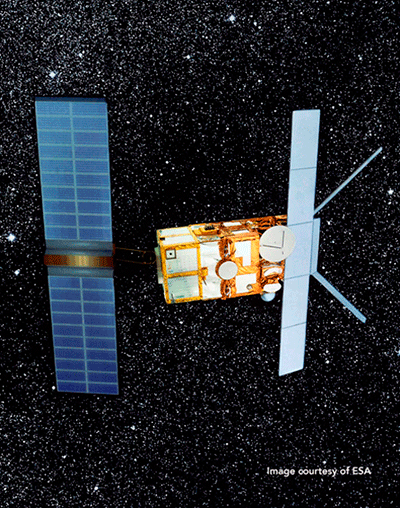25th anniversary of ERS-1, ESA’s oldest earth-observation satellite

On 17 July 1991 the European Space Agency (ESA)’s oldest earth-observation satellite blasted off from Europe’s spaceport in Kourou, French Guiana. This was Europe’s first ever radar satellite dedicated exclusively to the study of environmental matters.
ERS-1, weighing in at nearly 2.4 tons, was developed and built by an industrial consortium of over fifty companies from fourteen countries, primed by the company that today is Airbus Defence and Space. Not only was it the most modern and complex satellite of its time but also Europe’s first satellite equipped with radar and microwave instruments to take readings and capture images of the land and sea. This satellite made it possible for the first time ever to observe regions of the earth normally shrouded in cloud or mist and obtain images of the earth’s surface in any weather, day or night.
ERS-1 was initially conceived for a useful life of three years but ended up working three times as long. By the time it arrived at the end of its useful life in 2000, it had orbited the planet 45,000 times, sending 1.5 million images back to earth.
ERS-1’s incorporation of a radar instrument greatly improved the resolution of EO satellites and paved the way for the technology and applications used in the later radar satellites, ERS-2 and Envisat. ERS-1 set the tone for ongoing monitoring of our planet, giving us increasing insights into its complex climate systems.
Under an umbrella contract with ESA’s European Space Operations Centre (ESOC) in Germany, GMV participated in the development of the flight dynamics subsystem both of ERS-1 and its successor, ERS-2. GMV personnel formed part of the Flight Dynamics operations team of ERS-1 and ERS-2, supporting trajectory control activities and the generation of necessary commands for controlling the orbit and attitude of both satellites.
Nowadays the global monitoring program is living through a new era in terms of managing the environment, understanding and confronting the effects of climate change and guaranteeing citizen security. This is being done by means of a wide range of information services for a great number of practical applications, thanks to ESA’s new family of satellites, the Sentinels.
Fitted with a powerful synthetic aperture radar (SAR), the Sentinel satellites guarantee continuity of the pioneering work of ERS-1 and 2 and also the Envisat satellite. Their technology is based on a solid inheritance of satellite radar, initiated with ERS-1 25 years ago.
The Sentinel missions are being carried out within the Global Monitoring for Environment and Security program called Copernicus, in which GMV is still working busily on several projects in both the ground and space segments.